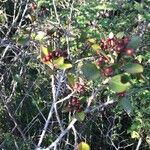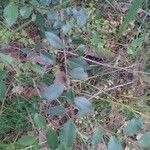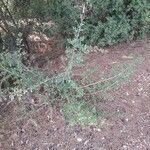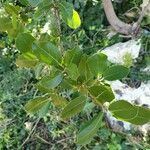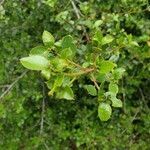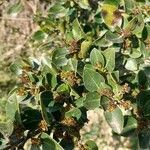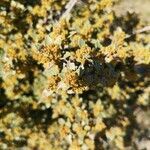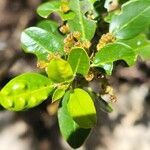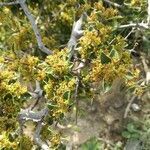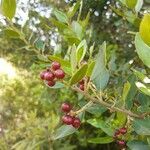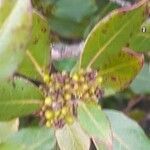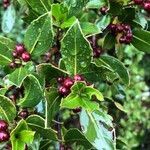Evergreen shrub to c. 5 m high, often < 1 m in exposed sites. Shoots angular, hairy, usually purple when young. Stipules subulate. Petiole 3-11 mm long, hairy, at least on upper side. Lamina 1.5-6 × 1-3 cm (sometimes smaller on flowering shoots), elliptic or elliptic-obovate, coriaceous, glossy above, becoming glabrous except for base of midrib below, entire to crenate-serrulate; base cuneate; apex acute or mucronate. Fls green, fragrant, usually in hairy bracteate racemes, sometimes infl. racemose-paniculate. Calyx lobes 4-(5), < tube, 1.7-2 mm long, reflexed, usually red-margined. Petals 0. Stamens 1-1.7 mm long. Drupe (4)-5-7 mm long, broad-obovoid, dark glossy red, becoming black.
Shrubs, 0.5–6(–10) m, unarmed. Branchlets purplish brown, puberulent. Leaves persistent, alternate; petiole 4–10 mm; blade dull to glossy yellowish green on both surfaces, elliptic to elliptic-obovate, ovate, or ovate-lanceolate, 2–4(–6) cm, distinctly coriaceous, base acute to obtuse, margins sharply serrate to spinulose-serrate, apex acute to subspinulose, both surfaces glabrous except abaxial vein axils tomentose; secondary veins (3–)4–5 pairs, basal pair diverging much more acutely than distal pairs. Inflorescences cymes or flowers solitary. Pedicels 2–6 mm. Sepals 5. Petals 0. Drupes dark red, becoming black, globose, 5–7 mm; stones 3.
A small tree.
